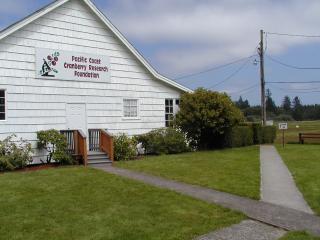August 10, 2001 - High fog, low 59, high 67, cloudy all day.
Today’s outing took us to Fort Canby in Ilwaco at the southern end of the peninsula. There was a lot to see in this area including two lighthouses, the Lewis and Clark Interpretive Center and the Fort Canby gun emplacements.
We started off at the North Head Lighthouse which was built in 1898. It was built to help ships coming from the north to locate the mouth of the Columbia River. The area it helps protect is called Cape Disappointment and often referred to as the “Graveyard of the Pacific” due to the tremendous number of shipwrecks.

North Head Lighthouse
The lighthouse still functions today and is run by the Coast Guard. The original Fresnel lens was made in 1841 and had been installed in three previous lighthouses.

Original North Head Lighthouse Fresnel lens
It produced light using kerosene at a rate of five gallons per night. The light could be seen for 20 miles. The original cost of the lens was $4,500 and would cost over $6 million to make today. The lens has been replaced and is on display in the Lewis and Clark Interpretive Center. The lighthouse is open to tours for a $1.00 donation.
The original residences for the lighthouse keepers have been redone and can be rented for overnight stays. This looks like it would be a great place to stay while exploring the area. For information on the facilities call (360) 642-3078.

North Head Lighthouse keepers residence
The Cape Disappointment Lighthouse is not open to the public but can be seen from the Lewis and Clark Interpretive Center. This lighthouse marks the northern entrance to the Columbia River.

Cape Disappointment Lighthouse from Fort Canby
While it helped ships from the south many ships from the north continued to shipwreck on the rocks and shifting sand bar. That’s why the North Head Lighthouse was built.
The Lewis and Clark Interpretive Center is a very nice building with a fantastic view of Cape Disappointment. There is a walking tour that starts at the beginning of their journey in Camp Dubois, Illinois and ends at Long Beach, Washington.

The Lewis and Clark Trail
There are very nice pictures and artifacts along with many quotes from the diaries of the men documenting their exploration and arrival at the Pacific Ocean in November of 1805.
There is a gift shop that has many wonderful books on the expedition. There are several different sets of books with the entire journal entries from everyone on the trip.
Just outside the Interpretive Center is the old gun emplacements built in 1862 to protect the mouth of the Columbia River. These gun emplacements were expanded and improved until the end of World War II. The old cannons are long gone but the concrete bases and ammunition storage bunkers are still there.
Fort Canby has 250 campsites each with a stove and table. Sixty of the campsites have water, sewer and electricity and 27 have water and power. All of the restrooms have hot showers and accommodate people with disabilities. There are 25 picnic sites located throughout the park. There are seven trails to explore the forest and headlands of the park.
On our way back to the campground we stopped by the Cranberry Museum in Long Beach.

Cranberry Museum
It is owned and operated by the Pacific Coast Cranberry Research Foundation. It is mainly a volunteer organization to help improve the quality and yield of cranberry crops. Washington State University originally owned the facility and the foundation purchased it in 1993. The university continues to do research in the 10-acre demonstration farm that is part of the property while local growers farm the bogs. There is an additional 40-acers owned by the foundation for research.
The museum has a little interpretive exhibit that shows the process of growing cranberries. There are a number of different tools and machines on exhibit.

Cranberry Museum interpretive exhibit
Along with the museum is a gift shop with many cranberry influenced items. Marilyn bought a kite in the store so she would have something to do while I go fly mine.
Visit the Cranberry Museum web site at www.cranberrymuseum.com.
We spent the rest of the afternoon flying our kites in a nice breeze on the beach. Then it was Mocha time, supper and more Myst III.
This was our last night and we really wanted to complete the Myst adventure but it was not to be. We got hung up on one puzzle and gave up. Tomorrow it’s back to the Seattle area where the temperature has been near 90 degrees F for the past few days. After a week at the beach and high 60-degree weather I’m sure it will be a shock to our system.
We hope you’ve enjoyed our little adventure and look forward to many more.


